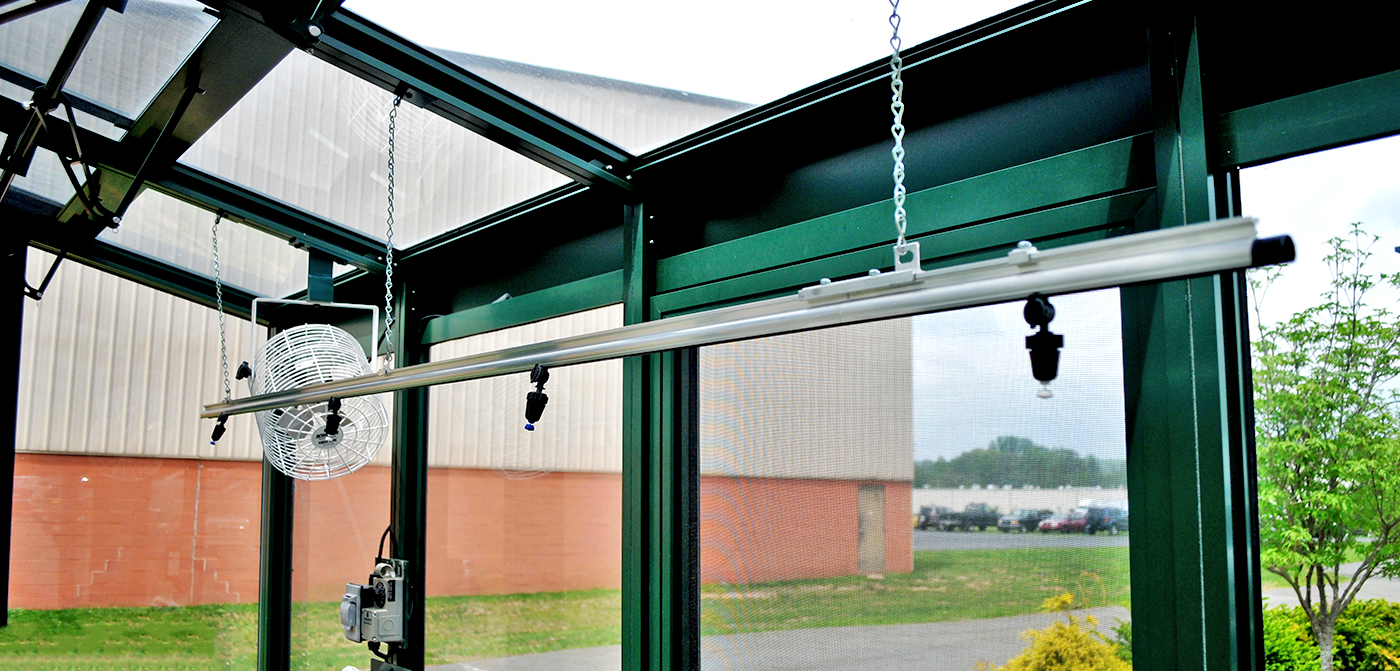

Greenhouse Misting Systems
In a greenhouse, there are two primary methods of inline irrigation – drip and misting systems. While the two systems may be used together, this article will provide an overview of the operation and setup of misting systems.
Benefits
A misting irrigation system simulates rainfall, watering the entire plant gently and evenly. Unlike drip systems, which deliver small amounts of water over an extended period of time, a misting system delivers copious amounts of water and can quickly saturate plants. Because of this, they should be closely monitored or tied to an environmental control system, as the plants can quickly become overwatered. A misting system can serve a wide variety of plant sizes – limited only by the distance above the bench that the system is installed. Though most are mounted either 24 or 36 inches above the bench, these systems can be mounted as high as desired. A misting system can work in tandem with a drip system and be segmented into zones to deliver differing hydration levels to multiple benches within the same greenhouse.

Setup
When planning the construction of a greenhouse, a water supply and proper drainage is required.
 The main line of the system should be constructed of either 1” or 3/4” PVC or polyethylene tubing. Twist-on fittings can be used for polyethylene tubing, making for a quick and easy installation. At the water source, an inline filter should be installed first, followed by a manual shut-off valve. Misting systems are designed to operate between 15-70 psi. If the water pressure of the system is too high, a pressure regulator can be installed. For a multi-zone system, it is at this point that the system should be divided into multiple runs, each controlled by its own shut-off valve or solenoid for electronically controlled systems. For rolling benches, it is recommended that flexible hose, such as garden hose, be used for each bench, or between adjacently connected benches, to maximize mobility.
The main line of the system should be constructed of either 1” or 3/4” PVC or polyethylene tubing. Twist-on fittings can be used for polyethylene tubing, making for a quick and easy installation. At the water source, an inline filter should be installed first, followed by a manual shut-off valve. Misting systems are designed to operate between 15-70 psi. If the water pressure of the system is too high, a pressure regulator can be installed. For a multi-zone system, it is at this point that the system should be divided into multiple runs, each controlled by its own shut-off valve or solenoid for electronically controlled systems. For rolling benches, it is recommended that flexible hose, such as garden hose, be used for each bench, or between adjacently connected benches, to maximize mobility.
For each bench, or series of benches, the misting system can be installed two ways – bench-mounted or ceiling-hung. For a bench-mounted system, aluminum risers are attached to the bench(es) at 12-foot intervals, centered along the length of the bench(es). Polyethylene tubing is snapped into an aluminum pipe hanger and hung from the risers. The benefit of a bench-mounted system is that the misting system will travel with a rolling bench as it is repositioned. For a ceiling-hung system, jack chain is attached to the rafters of the greenhouse and lowered to the desired height. The tubing is then snapped into the pipe hanger and hung from the jack chain. At the end of the run, a plug must be installed. Using a hole punch, punch holes every 30 inches into the tubing. For optimal coverage, it is recommended to use an even amount of downward and outward spray pattern nozzles, inserted into the holes in an alternating pattern. Each barbed nozzle sprays in a 360° pattern with a flow rate of 0.48 gpm (1.8 lpm) and includes its own check valve, which prevents dripping.
For a completely automated system, an environmental control system can be incorporated. The considerations involved with this type of automation is covered in another blog post. To get a broader sense of greenhouse irrigation, read Solar Innovations’ Greenhouse Irrigation Overview blog.
For more information on greenhouses, greenhouse accessories, or any other Solar Innovations® products, please contact Solar Innovations® directly at [email protected] or call 800 618 0669.

